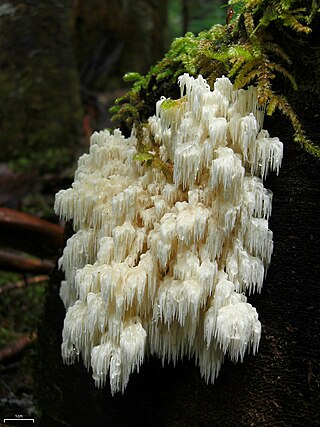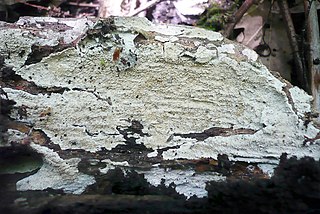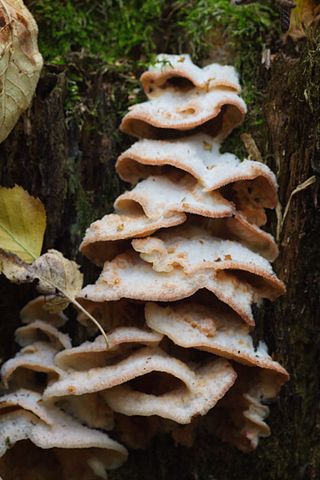
A mushroom or toadstool is the fleshy, spore-bearing fruiting body of a fungus, typically produced above ground, on soil, or on its food source. Toadstool generally denotes one poisonous to humans.

The Polyporales are an order of about 1800 species of fungi in the division Basidiomycota. The order includes some polypores as well as many corticioid fungi and a few agarics. Many species within the order are saprotrophic, most of them wood-rotters. Some genera, such as Ganoderma and Fomes, contain species that attack living tissues and then continue to degrade the wood of their dead hosts. Those of economic importance include several important pathogens of trees and a few species that cause damage by rotting structural timber. Some of the Polyporales are commercially cultivated and marketed for use as food items or in traditional Chinese medicine.

Hericium erinaceus is an edible mushroom belonging to the tooth fungus group. Native to North America, Europe, and Asia, it can be identified by its long spines, occurrence on hardwoods, and tendency to grow a single clump of dangling spines. The fruit bodies can be harvested for culinary use.

Mycoacia is a genus of toothed crust fungi in the family Meruliaceae. It was circumscribed by Dutch mycologist Marinus Anton Donk in 1931.

Exidia glandulosa is a jelly fungus in the family Auriculariaceae. It is a common, wood-rotting species in Europe, typically growing on dead attached branches of oak. The fruit bodies are up to 3 cm (1.2 in) wide, shiny, black and blister-like, and grow singly or in clusters. Its occurrence elsewhere is uncertain because of confusion with the related species, Exidia nigricans.

Ascocoryne sarcoides is a species of fungus in the family Helotiaceae. The species name is derived from the Greek sarkodes (fleshy). Formerly known as Coryne sarcoides, its taxonomical history has been complicated by the fact that it may adopt both sexual and asexual forms. Colloquially known as jelly drops or the purple jellydisc, this common fungus appears as a gelatinous mass of pinkish or purple-colored discs. Distributed widely in North America, Europe, Oceania and Asia, A. sarcoides is a saprobic fungus and grows in clusters on the trunks and branches of a variety of dead woods. Field studies suggest that colonization by A. sarcoides of the heartwood of black spruce confers some resistance to further infection by rot-causing fungi. A. sarcoides contains the antibiotic compound ascocorynin, shown in the laboratory to inhibit the growth of several Gram-positive bacteria.
Mycoleptodonoides is a genus of tooth fungi in the family Meruliaceae. The genus was circumscribed by M.I. Nikolajeva in 1952 with M. vassiljevae, described from Ussuri, Russia, as the type species. This fungus, known only from the type locality and northern China, is little known. The more widely distributed M. aitchisonii is found in habitats ranging from subtropical to boreal. The generic name combines the name Mycoleptodon and the Greek root -oides, meaning "resembling".

The hydnoid fungi are a group of fungi in the Basidiomycota with basidiocarps producing spores on pendant, tooth-like or spine-like projections. They are colloquially called tooth fungi. Originally such fungi were referred to the genus Hydnum, but it is now known that not all hydnoid species are closely related.

Hericium abietis, commonly known as the bear's head or the western coral hedgehog, is an edible mushroom in the tooth fungus group. It grows on conifer stumps or logs in North America, producing a cream white fruit body up to 10–75 cm (4–30 in) tall and wide. It fruits from after the start of the fall rains to mid-season.

Phlebia radiata, commonly known as the wrinkled crust, is a common species of crust fungus in the family Meruliaceae. It is widespread in the Northern Hemisphere. It grows as a wrinkled, orange to pinkish waxy crust on the decaying wood of coniferous and deciduous trees, in which it causes a white rot. The fungus was first described scientifically in 1821 by Elias Magnus Fries.

Nigroporus vinosus is a species of poroid fungus in the family Steccherinaceae, and the type species of the genus Nigroporus. Its fruit bodies have brownish caps with tinges of purple or red. The cap underside has a pore surface the same colour as the cap, and minute pores. Nigroporus vinosus has a pantropical distribution. It has been recorded from Africa, North America, Central America, South America, Asia, and Oceania. It is a wood-decay fungus that causes a white rot.

Crustomyces subabruptus is a species of toothed crust fungus in the family Cystostereaceae.

Metuloidea murashkinskyi is a species of tooth fungus in the family Steccherinaceae. It is found in Europe and Asia, where it causes a white rot on the wood of deciduous trees.
Mycoacia rubiginosa is a species of toothed crust fungus in the family Meruliaceae. It was described as a new species in 2004 by mycologists Kurt Hjortstam and Leif Ryvarden. The type collection was made in Sierra Nevada de Santa Marta, in Magdalena, Colombia, where the fungus was found growing on dead hardwood. It is known only from the type locality. Fruit bodies of M. rubiginosa are distinguished by their reddish colour, and spines up to 3 mm (0.12 in) long. The hyphal system is monomitic, containing only generative hyphae. The spores are ellipsoid, smooth, thin-walled and translucent, with dimensions of 4–4.5 by 2.5–2.75 µm.
Mycoleptodonoides tropicalis is a species of tooth fungus in the family Meruliaceae. It was described as new to science in 2013 by mycologists Hai-Sheng Yuan and Yu-Cheng Dai. The type collection was made in the Xishuangbanna Tropical Botanical Garden in Mengla County, where the fungus was found fruiting on a decaying angiosperm trunk. The specific epithet tropicalis refers to the tropical forest habitat.
Phlebiporia is a fungal genus in the family Meruliaceae. It was proposed in 2013 by Chinese mycologists to contain the single species Phlebiporia bubalina, a crust fungus. This fungus has a monomitic hyphal system with simple septa, and dextrinoid and thick-walled generative hyphae. There are thin-walled quasi-binding hyphae in the subiculum. Phlebiporia makes spores that are small, smooth, and ellipsoid.
Luteoporia is a fungal genus in the family Meruliaceae. It is monotypic, containing the single white rot species Luteoporia albomarginata, found in China. Macroscopic characterics of this fungus include its annual growth habit, and crust-like fruit bodies with yellow pores. Microscopic characteristics include a monomitic hyphal system with clamp connections, hyphae in the trama featuring swollen tips projecting out of the hymenium, and spores that are hyaline, thin-walled, and oblong-ellipsoid. The type collection was made in Wuzhishan Nature Reserve, where it was found growing on rotten angiosperm wood. The generic name Luteoporia refers to the yellow pore surface, while the specific epithet albomarginata refers to the white margin of the fruit body.
Climacodon sanguineus is a rare species of tooth fungus in the family Meruliaceae that is found in Africa.

Phlebia tremellosa, commonly known as trembling Merulius or jelly rot, is a species of fungus in the family Meruliaceae. It is a common and widely distributed wood-decay fungus that grows on the rotting wood of both hardwood and conifer plants.
Uncobasidium luteolum is a species of crust fungus in the family Meruliaceae, and the type species of genus Uncobasidium. The holotype was collected in Øvre Dividal National Park, in Målselv (Norway), where it was growing on Salix. The fungus has a monomitic hyphal system, with individual hyphae measuring 2.5–4 μm and having a clamp connection and oily refractive contents. The basidia are four-sterigmate, measure 30–50 by 8 µm, and feature a hook-shaped protuberance. Its spores are ellipsoid to obovate in shape, measuring 9 by 6 µm. Uncobasidium roseocremeum, found in South America, differs microscopically from U. luteolum in its larger, spherical spores, and the presence of encrusted hyphidia.













